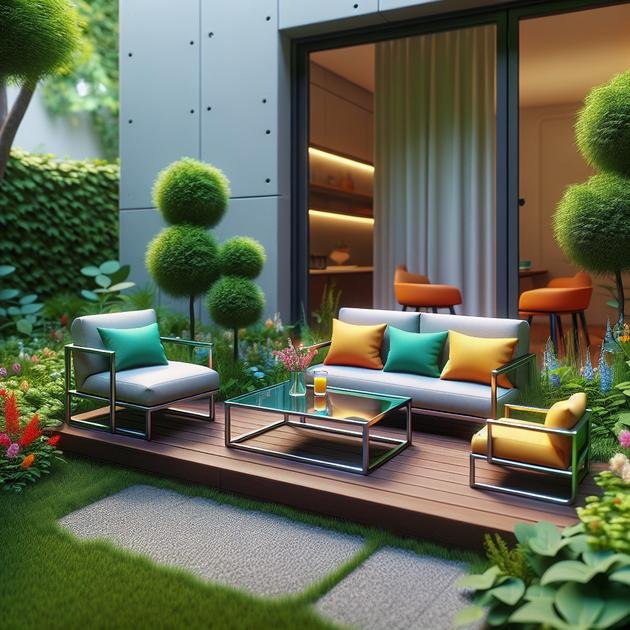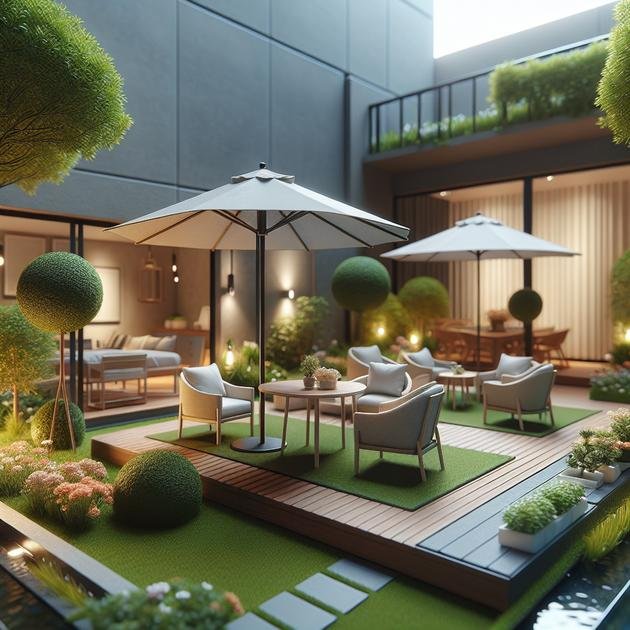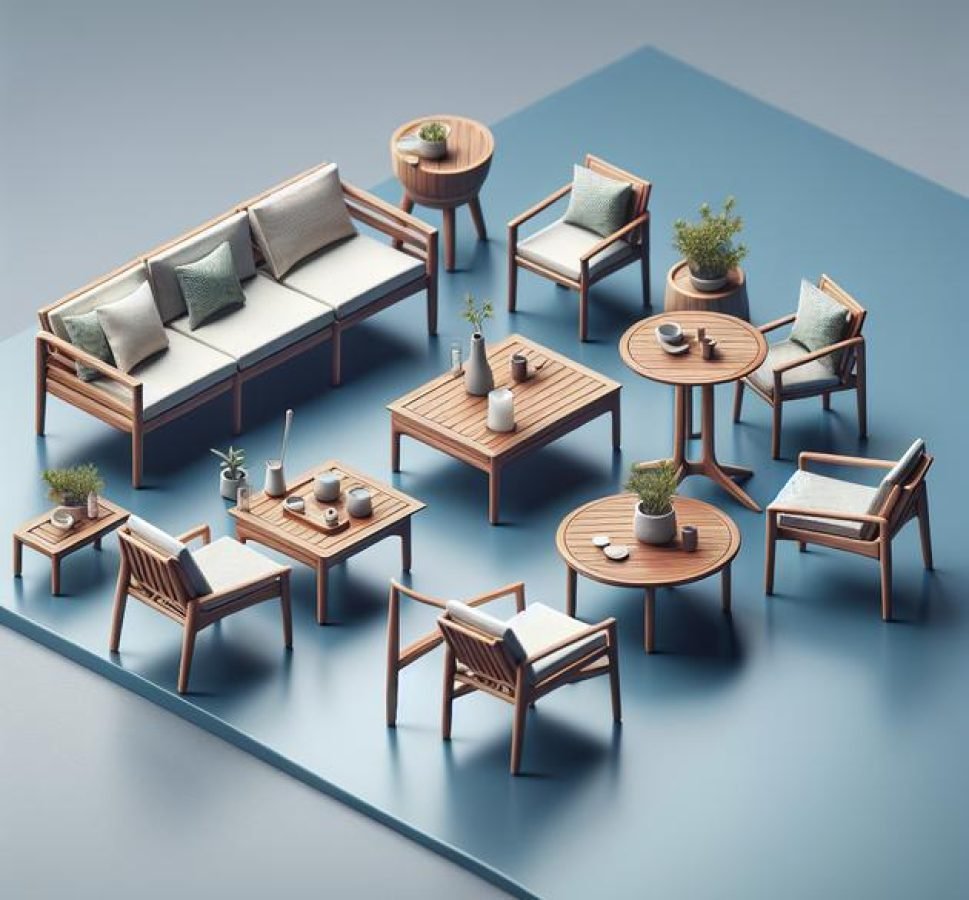Tiny patio furniture refers to compact, space-saving outdoor pieces designed for small patios, offering stylish, durable, and versatile options that maximize comfort and functionality in limited outdoor spaces.
Tiny patio furniture can make a huge difference when you’ve got limited outdoor space. Ever wondered how to create a comfy spot without crowding your patio? Let’s explore smart ideas that fit small areas beautifully.
how to choose the right tiny patio furniture
Choosing the right tiny patio furniture starts with understanding your space and needs. Measure your patio accurately to know how much room you have. Choose furniture that fits comfortably without overcrowding, allowing easy movement.
Consider the style and functionality that suit your outdoor lifestyle. If you entertain guests often, select seating that accommodates more people with compact designs. For solo relaxation, a small lounge chair or a bistro set might be perfect.
Materials matter a lot for durability and maintenance. Look for weather-resistant options like aluminum, teak, or synthetic wicker that withstand outdoor elements. Also, think about the weight if you plan to move furniture frequently.
Think about multi-purpose pieces, such as benches with storage or foldable tables, to maximize utility. Choosing furniture with cushions adds comfort and can brighten up the area with color.
Lastly, don’t forget to check for design harmony between your tiny patio furniture and the overall outdoor decor. This creates a cohesive look that feels inviting and functional.
space-saving furniture designs for small patios
Space-saving furniture designs are essential for making the most of small patios. Look for pieces that fold, stack, or nest easily, so you can store them when not in use and save precious space.
Compact tables with leaves or drop-down sides offer flexibility for different needs. Folding chairs and stools provide additional seating without crowding your area.
Consider benches with built-in storage to hide cushions, blankets, or gardening tools, keeping your patio tidy and functional.
Wall-mounted or hanging furniture, like fold-down tables or hanging planters with seats, free up floor space and add a unique style touch.
Multi-purpose pieces, such as ottomans that double as seats and storage, maximize usability while keeping the design sleek and minimal.
Choosing lightweight materials makes rearranging simple and effortless, perfect for adapting your space to different activities.
materials best suited for tiny patio furniture
Choosing the right materials is key to durable and attractive tiny patio furniture. Some materials stand out for their weather resistance and low maintenance, making them perfect for small outdoor spaces.
Metal furniture such as aluminum or wrought iron offers strength and modern style. Aluminum is lightweight, rust-resistant, and easy to move around. Wrought iron is heavier but very durable and adds a classic touch.
Wood furniture like teak, cedar, or eucalyptus provides natural beauty and warmth. Teak is especially valued for its oils which protect against water damage and insects, making it long-lasting outdoors.
Synthetic materials such as resin wicker or plastic are great for affordability and upkeep. Resin wicker mimics the look of natural wicker but is more weatherproof, while plastic options can be very lightweight and easy to clean.
Fabric choices for cushions also matter. Look for outdoor-grade, water-resistant fabrics like solution-dyed acrylic that resist fading, mildew, and moisture.
Considering climate in your area helps select the best material. For example, humid or rainy regions benefit from synthetic or treated woods, while dry climates allow for more variety.
color and style tips to enhance small patios

Choosing the right colors and styles can greatly enhance the look of small patios. Light and neutral colors like whites, creams, and pastels make the space feel larger and brighter. These shades reflect sunlight and create an airy atmosphere.
Adding pops of color with cushions, rugs, or planters draws the eye and adds personality without overwhelming the space. Bold colors like turquoise, coral, or mustard work well as accents.
For style, aim for simplicity and minimalism to avoid clutter. Sleek, modern designs or natural, rustic elements can both complement small patios beautifully.
Mixing textures adds depth—think of combining smooth metal with soft fabrics, or natural wood with woven wicker. This creates visual interest and comfort.
To unify the look, repeat key colors and materials throughout the patio. This gives a cohesive flow that feels planned and inviting.
Plants also play a role, with green foliage contrasting nicely against colored furniture and helping the space feel fresh and lively.
multi-functional furniture pieces for versatility
Multi-functional furniture is a smart choice for tiny patios because it offers versatility without taking up extra space. Items like ottomans that double as storage containers can hold cushions, blankets, or gardening tools, keeping your area neat.
Foldable tables and chairs allow you to create seating or dining space only when needed. This flexibility is ideal for small patios that serve multiple purposes.
Benches with built-in storage offer additional seating while hiding away items out of sight. Some even have lift-up seats or side compartments for easy access.
Convertible pieces such as sofa beds or stacking stools provide extra sleeping options for guests or additional chairs during gatherings.
Using multi-purpose furniture helps optimize your patio’s functionality and keeps it clutter-free, making your outdoor space more enjoyable and practical.
tips for arranging tiny patio furniture efficiently
Efficiently arranging tiny patio furniture requires thoughtful planning to maximize comfort and space. Start by creating zones for different activities, such as seating, dining, or planting, to keep the area organized.
Place larger pieces like benches or tables against walls or corners to free up central space. This helps make the patio feel more open and allows easy movement.
Using corner furniture or L-shaped seating can take advantage of awkward spaces, providing ample seating without crowding.
Leave enough room between pieces for walking paths, ideally around 2 feet, to maintain good flow and usability.
Stackable or foldable furniture can be tucked away when not in use, keeping the area open and uncluttered.
Adding small side tables instead of large ones helps save space while still providing surfaces for drinks or plants.
Consider vertical elements like shelves or hanging planters to draw the eye upward and add function without taking up floor space.
budget-friendly options for small outdoor setups
Finding budget-friendly options for tiny patio furniture doesn’t mean sacrificing style or comfort. Start by exploring affordable materials like plastic, resin, or lightweight metal, which often cost less but can still look great and last long.
Look for sales, discounts, or secondhand pieces that can be refreshed with a little DIY effort. For example, a coat of weatherproof paint or new cushions can transform old furniture.
Consider simple designs with fewer parts, as these are usually more affordable and easier to maintain. Foldable or stackable furniture often comes at a lower price and provides flexibility.
Mix and match budget pieces with a few investment items, such as quality cushions or a well-made table, to balance cost and durability.
Thrift stores, online marketplaces, and discount retailers are great places to hunt for deals on tiny patio furniture.
Adding your own DIY touches like handmade cushions or painted pots can personalize the space without breaking the bank.
incorporating plants with tiny patio furniture

Incorporating plants with tiny patio furniture adds life, color, and a sense of calm to small outdoor spaces. Use vertical planters, hanging baskets, or railing pots to save floor space while adding greenery.
Small potted plants can be placed on tables, shelves, or benches to bring natural beauty close to your seating area. Choose plants suited for your patio’s light and climate conditions, such as succulents, ferns, or flowering annuals.
Mix different plant sizes and textures to create an inviting and dynamic look. For example, combine tall grasses with low ground covers or trailing vines to soften furniture edges.
Consider using planters that double as furniture pieces, like storage benches with built-in plant boxes or side tables with integrated pots, maximizing functionality.
Regular care like watering and pruning keeps the plants healthy and the patio fresh. Adding fragrant herbs or flowers can also enhance your outdoor experience.
Thoughtful plant placement complements your tiny patio furniture, creating a harmonious and cozy outdoor retreat.
weatherproofing your tiny patio furniture
Weatherproofing your tiny patio furniture protects it from sun, rain, and other elements, extending its life and maintaining its look. Start by choosing materials like teak, aluminum, or resin wicker that naturally resist weather damage.
Use waterproof covers when furniture is not in use to shield cushions and frames from moisture and dirt. This simple step can prevent mold and fading.
Applying sealants or protective sprays designed for outdoor furniture adds an extra barrier against water and UV rays. Reapply these treatments as recommended to ensure ongoing protection.
Store cushions and fabric pieces indoors during harsh weather or winter months to avoid mildew and tearing.
Regular cleaning with mild soap and water removes dirt and prevents decay. Avoid harsh chemicals that can damage finishes or fabrics.
Raising your furniture slightly off the ground with pads or feet can improve drainage and prevent water damage to legs and corners.
mixing and matching furniture styles
Mixing and matching furniture styles can add character and charm to your tiny patio. Start by choosing a common element, like color or material, to create cohesion between different pieces.
Combine modern and vintage items for an eclectic yet balanced look. For example, a sleek metal chair paired with a rustic wooden table can create visual interest.
Don’t be afraid to mix materials such as wood, metal, and wicker. Textural contrasts enhance the appeal without overwhelming the space.
Use patterns or solid colors in cushions and textiles to tie diverse furniture pieces together. Neutral tones with bright accent colors work well.
Keep scale and proportion in mind to ensure no piece looks out of place. Smaller, streamlined furniture pairs best with intricate or bold designs.
Adding personal touches like outdoor rugs or throw pillows can unify styles and make the space feel welcoming.
creative seating ideas for limited spaces
Creative seating ideas can make a small patio both functional and stylish. Consider built-in benches along walls or corners to maximize seating without cluttering the floor. These can often double as storage spaces.
Stackable or foldable chairs provide flexible seating options that can be tucked away when not in use. Lightweight stools or poufs add seating that is easy to move.
Use hanging chairs or swings if your patio structure supports them; these add fun and save floor space.
Window seats with cushions can create cozy nooks without taking extra room. Modular seating allows you to rearrange pieces to fit different occasions.
Adding floor cushions and outdoor rugs creates casual seating areas, perfect for relaxing or entertaining guests.
Choosing multi-functional seating, like ottomans with storage, helps keep your patio tidy and versatile.
lighting solutions that complement small patios

Lighting is essential for creating a cozy and inviting atmosphere on small patios. String lights are a popular choice; they add a warm glow without taking up space, making the area feel magical and intimate.
Solar-powered lights are eco-friendly and easy to install. You can place them along pathways, around furniture, or among plants to highlight features and improve safety.
Lanterns and candles offer soft, flickering light that enhances relaxation. Use battery-operated or LED candles for safety and convenience.
Wall-mounted or overhead fixtures provide focused illumination without occupying floor space. Adjustable designs let you direct light where needed, perfect for dining or reading.
Consider incorporating dimmers or timers to control brightness and energy use, allowing you to set the perfect mood anytime.
Using a mix of lighting types adds layers and depth, making your tiny patio feel larger and more welcoming after sunset.
maintaining and cleaning tiny outdoor furniture
Maintaining and cleaning tiny outdoor furniture keeps it looking fresh and extends its lifespan. Regularly wipe down surfaces with a soft cloth and mild soap to remove dirt and dust.
For metal furniture, check for rust spots and use a rust remover or touch-up paint as needed. Avoid abrasive cleaners that can damage finishes.
Wood furniture benefits from cleaning with gentle wood cleaners, followed by appropriate oiling or sealing every few months to protect against weather damage.
Clean fabric cushions and covers according to manufacturer instructions. Most outdoor fabrics can be spot cleaned or machine washed. Let cushions dry completely before use to prevent mold and mildew.
Using furniture covers when not in use helps protect against dust, rain, and sun damage.
Store furniture in a dry, sheltered place during extreme weather or winter to avoid unnecessary wear.
small patio furniture for different climate zones
Choosing small patio furniture suitable for your climate zone ensures durability and comfort. In hot, dry areas, materials like metal and synthetic wicker hold up well against sun and heat. Use UV-resistant fabrics to prevent fading.
For humid or rainy climates, select furniture made from teak, cedar, or treated wood that resists moisture and decay. Aluminum furniture also works well as it does not rust easily.
In cold or snowy regions, lightweight foldable furniture is practical for easy storage during winter. Weatherproof covers and proper sealing help protect pieces from frost and moisture.
Coastal areas require corrosion-resistant materials such as powder-coated metals or plastics to withstand salt air. Fabrics should be mildew-resistant and quick-drying.
Consider cushions and accessories that can be easily removed and stored according to weather changes.
Adapt your patio furniture choices to your local climate for a comfortable, long-lasting outdoor space.
where to buy quality tiny patio furniture
Finding quality tiny patio furniture involves looking at various sources that offer durable and stylish options. Specialty outdoor furniture stores often carry carefully curated selections designed specifically for small spaces.
Online marketplaces like Amazon, Wayfair, and Overstock provide a wide variety of styles and price points, along with customer reviews that help gauge quality.
Local garden centers and home improvement stores may offer budget-friendly pieces, with the added benefit of seeing items in person before purchase.
Buying directly from manufacturers or brands specializing in outdoor furniture can ensure better quality and warranty options.
Consider custom furniture makers if you want unique pieces tailored to your patio’s exact dimensions and style.
Always check return policies and read reviews to ensure a smooth buying experience and satisfaction with your tiny patio furniture.
Wrapping Up Your Tiny Patio Furniture Choices
Choosing the right tiny patio furniture can make a big difference in creating a cozy and functional outdoor space. By considering factors like materials, styles, and climate, you can find pieces that last and look great.
Don’t be afraid to explore budget-friendly options and mix different styles to reflect your personality. Adding plants and good lighting can really bring your patio to life.
Remember to maintain and clean your furniture regularly to keep it looking fresh season after season.
With these tips, your small patio can become a welcoming and stylish retreat you’ll enjoy year-round.





